A) The type of mood induction had a significant effect on responses to all of the nine items.
B) The type of mood induction had a significant effect on responses to at least one of the nine items.
C) The type of mood induction had a significant effect on responses to more than half at least of the nine items.
D) The type of mood induction that a person had could be significantly determined from a linear combination of responses to the nine items.
Correct Answer

verified
Correct Answer
verified
Multiple Choice
Which of the following is not an assumption of MANOVA?
A) Sphericity
B) Independence
C) Multivariate normality
D) Random sampling
Correct Answer

verified
Correct Answer
verified
Multiple Choice
A scientist was interested in the success of a newly developed sleep aid called 'Night Owl' on time taken to fall asleep and quality of sleep. She recruited 30 participants who were randomly allocated to receive either a dose of Night Owl or a placebo. The scientist measured the mean time taken for each participant to fall asleep (minutes) and the quality of their sleep (measured on a scale of 1 (poorest quality) to 10 (best possible quality) ) over the course of one week.
-What can the scientist conclude from the output below?
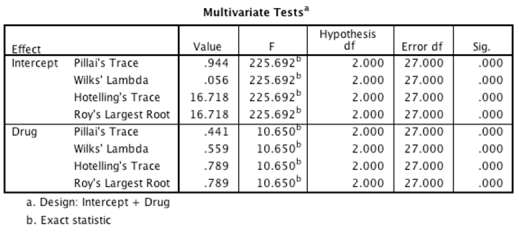
A) The type of drug taken had a significant effect on sleep.
B) The type of drug taken had a significant effect on both quality of sleep and time taken to get to sleep.
C) The type of drug taken had a small but significant effect on sleep.
D) Taking Night Owl resulted in less time taken to fall asleep and a significantly better quality of sleep than the placebo.
Correct Answer

verified
Correct Answer
verified
Multiple Choice
The matrix is:
A) A 4 * 2 matrix
B) A square matrix
C) A 2 * 4 matrix
D) An identity matrix
Correct Answer

verified
Correct Answer
verified
Multiple Choice
Which of the following sentences is false?
A) The residual cross-product tells us about how the relationship between the dependent variables is affected by individual differences, or error in the model.
B) The model cross-product is a gauge of the overall relationship between the dependent variables.
C) MANOVA uses the same sums of squares as ANOVA.
D) MANOVA has the power to account for any correlation between dependent variables by using cross-products.
Correct Answer

verified
B
Correct Answer
verified
Multiple Choice
When you have several outcome variables, what advantage does conducting a MANOVA have over conducting several ANOVAs?
A) Conducting several ANOVAs would increase the Type II error rate.
B) MANOVA doesn't rely on assumptions.
C) Conducting several ANOVAs would increase the Type I error rate.
D) MANOVA does not assume homogeneity of variances.
Correct Answer

verified
Correct Answer
verified
Multiple Choice
Cross-products:
A) Represent a total value for the combined error between two variables.
B) Represent the total squared difference between the observed values and the mean value.
C) Represent the effect(s) of two or more outcome variables multiplied together.
D) Compare the ratio of systematic to unsystematic variance for several dependent variables.
Correct Answer

verified
Correct Answer
verified
Multiple Choice
A psychologist was interested in gauging the success of a mood manipulation during one of her experiments. She had three groups of participants who underwent different types of mood induction: disgust mood induction, negative mood induction and positive mood induction. After the mood induction, participants were asked to endorse nine statements relating to their mood (on a 5-point Likert scale from 1 = disagree to 5 = agree) : (1) When you're smiling the whole world smiles with you, (2) I love the pretty flowers, (3) I could never touch a dead body, (4) I would never eat catfood, (5) If someone served me monkey brain soup I would vomit, (6) I feel fed up, (7) Bodily fluids are nasty, (8) I could not drink from a glass that I'd used to catch a spider, (9) I am a worthless piece of scum. - What analysis should be done to see if the mood inductions had an effect on responses to these nine items?
A) Factor analysis
B) Repeated-measures ANOVA
C) MANOVA
D) Mixed ANOVA
Correct Answer

verified
C
Correct Answer
verified
Multiple Choice
A scientist was interested in the success of a newly developed sleep aid called 'Night Owl' on time taken to fall asleep and quality of sleep. She recruited 30 participants who were randomly allocated to receive either a dose of Night Owl or a placebo. The scientist measured the mean time taken for each participant to fall asleep (minutes) and the quality of their sleep (measured on a scale of 1 (poorest quality) to 10 (best possible quality) ) over the course of one week. -How could the scientist analyse her data to investigate whether participants in the Night Owl group fell asleep faster and had a better quality of sleep than those in the placebo group?
A) Factor analysis
B) MANOVA
C) Two-way independent ANOVA
D) One-way Independent ANOVA
Correct Answer

verified
Correct Answer
verified
Multiple Choice
A psychologist was interested in gauging the success of a mood manipulation during one of her experiments. She had three groups of participants who underwent different types of mood induction: disgust mood induction, negative mood induction and positive mood induction. After the mood induction, participants were asked to endorse nine statements relating to their mood (on a 5-point Likert scale from 1 = disagree to 5 = agree) .
- A discriminant function analysis was performed on the data. The output is below. Which statement best sums up the results? Eigenvalues
a. First 2 canonical discriminant functions were used in the analysis.
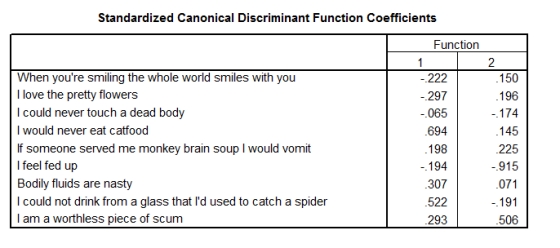
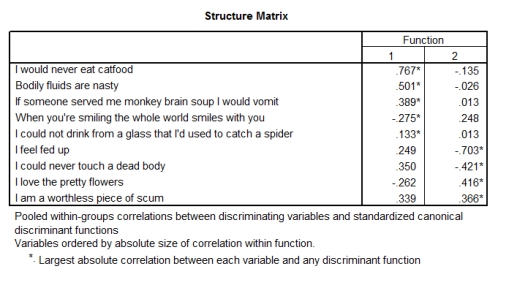
A) There were two significant underlying functions that differentiated the mood induction groups: one seems to reflect disgust, whereas the other reflects depression.
B) There was one significant underlying function that differentiates the mood induction groups: it seems to represent disgust.
C) There were two significant underlying functions that differentiated the mood induction groups, but it's unclear what these functions represent.
D) There were no significant underlying functions that could discriminate the mood induction groups.
Correct Answer

verified
Correct Answer
verified
Multiple Choice
A scientist was interested in the success of a newly developed sleep aid called 'Night Owl' on time taken to fall asleep and quality of sleep. She recruited 30 participants who were randomly allocated to receive either a dose of Night Owl or a placebo. The scientist measured the mean time taken for each participant to fall asleep (minutes) and the quality of their sleep (measured on a scale of 1 (poorest quality) to 10 (best possible quality) ) over the course of one week. -What does the output below show? Box's Test of Equality of Covariance Matrices Tests the null hypothesis that the observed covariance matrices of the dependent variables are equal across groups. a. Design: Intercept + Drug Bartlett's Test of Sphericity Tests the null hypothesis that the residual covariance matrix is proportional to an identity matrix. a. Design: Intercept + Drug
A) The assumption of equality of covariance matrices has been violated.
B) The assumption of sphericity has been met.
C) The covariance matrices are not significantly equal.
D) The covariance matrices are roughly equal as assumed.
Correct Answer

verified
Correct Answer
verified
Multiple Choice
In MANOVA, it can be a good idea to:
A) Include as many dependent variables in the analysis as possible.
B) Never include variables that are known to be theoretically meaningful.
C) Include the same number of dependent variables as independent variables to achieve a well-balanced design.
D) Run one analysis for variables being tested on a heuristic basis and a separate analysis for any theoretically meaningful variables.
Correct Answer

verified
Correct Answer
verified
Multiple Choice
Which of the following statements about MANOVA is false?
A) MANOVA reduces the Type I error rate when compared to conducting multiple ANOVAs.
B) If the multivariate test is significant then the univariate tests for at least one outcome variable will be too.
C) MANOVA takes account of the relationship between dependent variables.
D) MANOVA has the power to detect whether groups differ along a combination of dimensions.
Correct Answer

verified
Correct Answer
verified
Multiple Choice
A psychologist was interested in gauging the success of a mood manipulation during one of her experiments. She had three groups of participants who underwent different types of mood induction: disgust mood induction, negative mood induction and positive mood induction. After the mood induction, participants were asked to endorse nine statements relating to their mood (on a 5-point Likert scale from 1 = disagree to 5 = agree) .
-Which statement best sums up this part of the output? 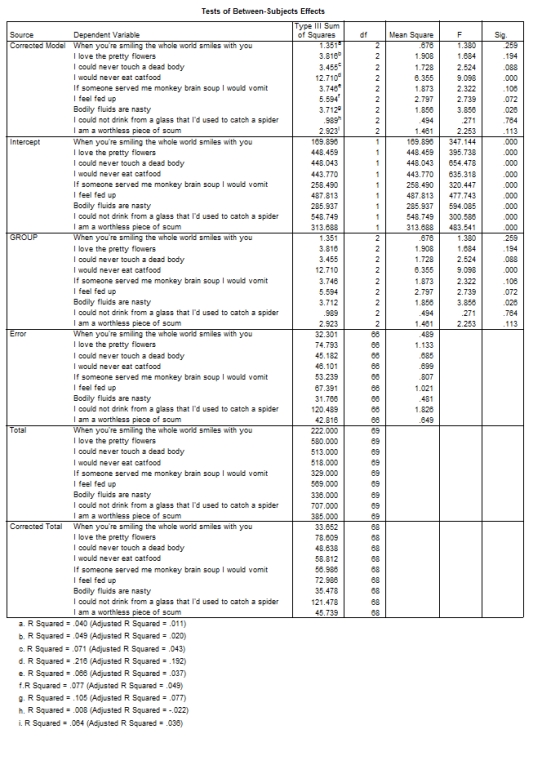
A) There were significant differences between the mood induction conditions on two items: 'I would never eat catfood', and 'Bodily fluids are nasty'.
B) There were significant differences between the mood induction conditions on all items.
C) There were significant differences between the mood induction conditions on four items: 'I would never eat catfood', 'I could never touch a dead body', 'I feel fed up' and 'Bodily fluids are nasty'.
D) The mood induction had no effect on responses to the nine items.
Correct Answer

verified
Correct Answer
verified
Multiple Choice
MANOVA requires:
A) The dependent variables to be heteroscedastic.
B) A stricter significance level than ANOVA.
C) More than one outcome variable.
D) Sphericity.
Correct Answer

verified
Correct Answer
verified
Multiple Choice
A psychologist was interested in gauging the success of a mood manipulation during one of her experiments. She had three groups of participants who underwent different types of mood induction: disgust mood induction, negative mood induction and positive mood induction. After the mood induction, participants were asked to endorse nine statements relating to their mood (on a 5-point Likert scale from 1 = disagree to 5 = agree) .
-Which statement best sums up this part of the output? 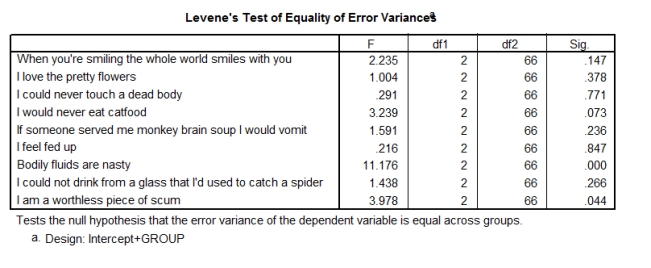
A) I need to transform all of the items.
B) There were significant differences between the mood induction conditions on two items: 'I am a worthless piece of scum' and 'Bodily fluids are nasty'.
C) There were significant differences between the mood induction conditions on three items: 'I am a worthless piece of scum', 'I would never eat catfood' and 'Bodily fluids are nasty'.
D) We can assume homogeneity of variance because most items show non-significant effects.
Correct Answer

verified
A
Correct Answer
verified
Multiple Choice
Which of the following statements is false?
A) In both ANOVA and MANOVA, the test statistic is derived by comparing the ratio of systematic to unsystematic variance for a dependent variable.
B) The test statistic in both ANOVA and MANOVA represents the ratio of the effect of the systematic variance to the unsystematic variance.
C) MANOVA uses the same sums of squares as ANOVA.
D) Separate ANOVAs on each outcome variable do not really bear any relation to what is tested in MANOVA.
Correct Answer

verified
Correct Answer
verified
Multiple Choice
Which of the following is false with regard to Box's test?
A) Box's test is susceptible to deviations from multivariate normality.
B) In large samples Box's test could be significant even when covariance matrices are relatively similar.
C) As a general rule, if sample sizes are equal then people tend to disregard Box's test because it is unstable.
D) The more dependent variables you have measured and the greater the differences in sample sizes, the less distorted the probability values become.
Correct Answer

verified
Correct Answer
verified
Multiple Choice
When following up a significant MANOVA, what is the advantage of conducting discriminant function analysis over separate ANOVAs?
A) Discriminant function analysis keeps the effects of each outcome variable independent.
B) Discriminant function analysis is true to the ethos of MANOVA.
C) Discriminant function analysis looks at the outcome variables as independent entities, not as a linear combination.
D) The overall multivariate test protects against inflated Type I error rates.
Correct Answer

verified
Correct Answer
verified
Multiple Choice
If we ran Box's test prior to conducting a MANOVA and obtained a value with an associated p-value less than .05, what would this tell us?
A) That the residuals are not independent.
B) That there are multivariate outliers present.
C) That the population variance-covariance matrices of the different groups in the analysis are equal.
D) That the assumption of homogeneity of variance-covariance matrices has been violated.
Correct Answer

verified
Correct Answer
verified
Showing 1 - 20 of 20
Related Exams